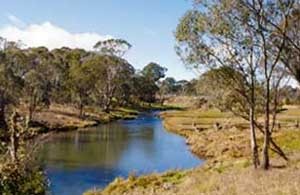
Why it matters
Coal seam gas extraction may increase the risk of interconnectivity between groundwater aquifers. This can reduce the quantity and quality of water in aquifers. Changing interconnectivity between aquifers can also affect surface water resources.
Large coal mines may disrupt surface flow through river diversions and flood protection works. Dewatering of the mine can also disrupt groundwater flow patterns.
Researchers also need to consider how these issues contribute to the overall cumulative impacts of coal seam gas extraction and coal mining both, different scales (local to regional) and over different time frames (tens to thousands of years).
Information on research projects, based on the Independent Expert Scientific Committee on Coal Seam Gas and Large Coal Mining Development’s (IESC’s) 2013 research priorities for hydrology, can be found on the Department of Agriculture, Water and the Environment website: Hydrology: changes in dynamics and aquifer interconnectivity
New priorities
The IESC’s 2017 revised research priorities for this theme are:
| Research priority | Key research needs |
|---|---|
| 1. Characterising hydraulic properties of aquifers and aquitards | Modelling of the impacts of coal seam gas extraction and coal mining on groundwater requires an understanding of the lithology, hydrogeological characteristics and geological structures of aquifers and aquitards. A better understanding is needed at local and regional scales of hydrogeological characteristics including values of storage properties and vertical hydraulic conductivity for key aquifers and aquitards. |
| 1a. Leveraging from petroleum engineering and geology data | The petroleum industry has detailed information and data on the properties of petroleum reservoirs. There is a research opportunity to improve understanding of deep aquifers by better linking hydrogeology and petroleum data. A process is needed to capture data on hydrogeological characteristics from both sources in national databases. |
| 1b. Linking groundwater models of different scales | Groundwater models used in assessment of impacts of coal seam gas extraction and coal mining are often at different spatial scales. A review of methods to link groundwater models of different scales would assist in analysing potential cumulative impacts of multiple developments. Linked to Hydrology priority 5c. |
| 1c. Dual phase and dual porosity flow and geomechanical effects in groundwater models | The research needs are to identify methods for representing these processes in a simplified way for regional modelling and estimating the magnitude of the consequent errors; assess the extent to which these factors influence regional modelling and prediction of the volumes of produced water; and develop relationships to identify the areas/environments and times for which these factors are important for regional groundwater modelling. |
| 2. Impacts to upland peat swamps and water bodies associated with coal mining | Temperate Highland Peat Swamps on Sandstone and Coastal Upland Swamps in the Sydney Basin Bioregion (collectively termed upland peat swamps) are listed as endangered ecological communities under the Environment Protection and Biodiversity Conservation Act 1999 (EPBC Act). Longwall coal mining beneath upland peat swamps may fracture the sandstone substrate and alter the swamps’ water balance. An improved hydro-geomechanical understanding is needed of the depth of fracturing near the ground surface, the height of fracturing above the mined seam that may enable connectivity to surface, and non-conventional subsidence including mining-induced reactivation of geological faults. Each of these processes may impact on the water holding capacity of the swamps. |
| 3. Hydraulic fracturing | The experience of hydraulic fracturing in Australian coal seams could be reviewed to assess the impact of fracture stimulation activities on well integrity, the failure rates associated with coal seam targeting during perforation, and to improve understanding of fracture growth in and beyond coal seams. This could potentially include developing leading practice guidelines for fracture growth modelling. |
| 4. Voids |
There is a lack of knowledge of the status and impact of final voids associated with open cut coal mines. The research need is to determine the number of voids; their types; water qualities; surrounding groundwater qualities; comparison of water qualities/quantities with model predictions; interaction between voids; impacts on surrounding environments; depth profiles of redox in voids and the effect on groundwater quality and flow characteristics. In 2021, the IESC funded a Scoping study - Coal mine voids, Queensland to increase the understanding of coal mine voids in Queensland through a scoping study to identify the location and potential impacts of these mine voids on the landscape. |
| 5. Assessment and modelling of groundwater and surface water connectivity | Groundwater extraction may lead to changes in the flow regimes in connected stream and wetlands. Prediction of the water-related impacts of coal seam gas extraction and coal mining relies on understanding the nature of the groundwater and surface water connectivity regime. |
| 5a. Improving understanding of groundwater recharge from surface water bodies | Groundwater recharge from floods is a major component of recharge to alluvial systems, but few groundwater models include flooding. A first step is a review of techniques to estimate flood recharge to alluvial systems near existing or proposed coal and coal seam gas operations, and consequent leakage to deeper aquifers. |
| 5b. Seepage relationships between surface water and groundwater | Seepage relationships between groundwater and surface water bodies are poorly quantified. Integrated modelling and measurements of seepage in priority areas will improve understanding of potential water-related impacts of coal seam gas extraction and coal mining. |
| 5c. Linking surface water and groundwater models | Surface water and groundwater models are usually at different spatial and temporal scales. This research priority would investigate ways to improve modelling of surface water impacts at finer scales. Linked to Hydrology priority 1b. |

